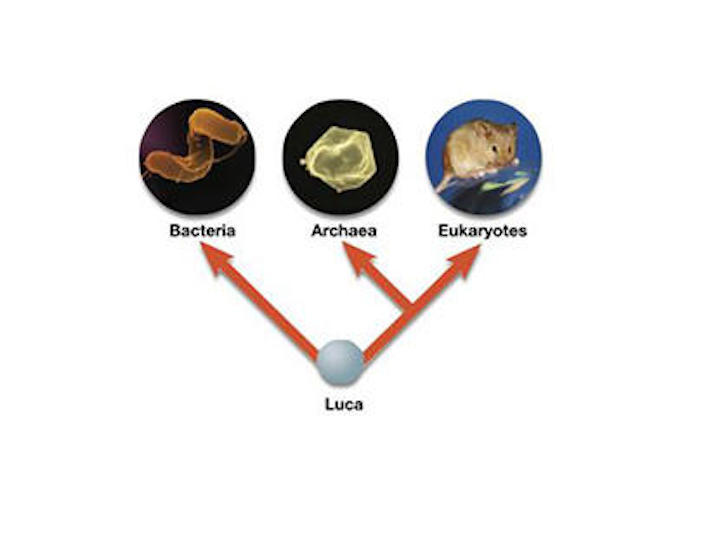23.09.2017
LUCA, our Common Ancestor
In the twentieth century, molecular biology established that all living organisms shared the same information-carrying macromolecules (DNA, RNA and proteins), and the same genetic code to transfer information between these molecules. This unity of the living world points to a common origin, an ancestor that had all these characteristics. As a nod to Lucy, the common ancestor was dubbed LUCA (an acronym for Last Universal Common Ancestor) during an international symposium organized in France by the Fondation des Treilles in 1996. Using data from comparative genomics, a then emerging discipline based on sequencing organisms belonging to the three domains of the living world (archaea, bacteria and eukaryotes), this research community set out to reconstruct the characteristics of LUCA. Last year, a new forum was held at the Fondation des Treilles to celebrate the twentieth anniversary of the naming of LUCA, review the data collected since 1996, and sketch out an initial outline of this ancestor.
Yet a frequent misunderstanding should first be cleared up: LUCA, which lived over three billion years ago, was not the first cell to appear on our planet. Comparative genomics has demonstrated the existence of three RNA molecules and 34 ribosomal1 proteins common to all living organisms and also therefore to LUCA. Given their complexity, these molecules could only have appeared after a long period of evolution. LUCA must therefore have shared the planet with many other organisms resulting from this same time span. However, its contemporaries left no descendants, which is not to say that they did not hand down certain genes to us, just as the Denisovans and Neanderthals did with our Homo sapiens ancestors. A parallel can also be made between LUCA and African Eve, the last mother common to all modern women: Eve was not the first Homo sapiens woman either, nor did she live alone in Africa at the time.
Two branches, same tree
Comparative genomics in ribosomes has also revealed that, in addition to the 34 universal proteins, modern ribosomes contain a large number of proteins unique to bacteria, archaea, and/or eukaryotes. One of their remarkable features is that they are either specific to one of the three domains, or shared by archaea and eukaryotes. Over the course of evolution, these proteins were therefore acquired in two separate lineages: one leading from LUCA to the bacteria, and the other from LUCA to the archaea and eukaryotes.

A widespread hypothesis is that LUCA gave birth to the three great domains of life, via two branches.
-
LUCA's ribosomes were therefore less complex than modern ones, with around half the number of proteins. Broadly speaking, comparison of molecular mechanisms in archaea and bacteria has shown that, in every case, these processes must have been considerably simpler in LUCA than in modern cells, and that increasing complexity occurred independently in bacteria on the one hand, and in archaea and eukaryotes on the other.
LUCA probably lacked the ultra-sophisticated molecular complexes found in modern organisms, which for instance enable them to produce energy very efficiently. Similarly, its genome was probably still composed of RNA, and it is possible that DNA and its replication mechanisms may have appeared twice independently, perhaps from very ancient viral lineages. The presence of viruses in LUCA's time is evidenced today by the existence of major virus families whose members infect either bacteria, archaea or eukaryotes.
A cold (or tepid) ancestor
The discovery of archaea living at very high temperatures initially suggested that LUCA itself was a hyperthermophile. The reconstruction of some of its ancestral sequences by a Lyon-based CNRS team headed by Manolo Gouy2 showed that this was probably not the case. However, the same team's work demonstrates that the ancestors of both bacteria and archaea lived at high temperatures. How then could a cold (or tepid) LUCA have evolved into the hot ancestors of bacteria and archaea? I have put forward the idea that organisms in both domains could have developed into their current forms by adapting to increasingly high temperatures. This shift could therefore have played a crucial role in the formation of the living world we know today.

Some thermophilic organisms derive their energy from hot springs rich in sulfur and iron oxide, as is the case with the Grand Prismatic Spring, a basin in Yellowstone Park (US).
-
We have yet to understand the emergence of eukaryotes, organisms whose cells—unlike archaea and bacteria—have a nucleus and organelles such as mitochondria (responsible for respiration) and chloroplasts (responsible for photosynthesis). A popular hypothesis postulates that eukaryotes are descended from an archaean that, by endosymbiosis, assimilated the bacterium from which mitochondria are derived. In 2015, a team from Sweden announced the discovery of Lokiarchaeota, which could be the missing link between archaea and eukaryotes. Our team's work has nonetheless shown that this conclusion was biased by several methodological artefacts. We prefer the theory that eukaryotes did not descend directly from archaea but share a common ancestor with them. Certain features of eukaryotes may thus have existed in LUCA and subsequently been lost in archaea and bacteria.
Without a time machine, drawing a portrait of LUCA and determining the shape of the universal tree of life will long remain controversial issues. However, the steady flow of fresh data from comparative genomics increasingly narrows down the possible scenarios. Watch this space!
The analysis, views and opinions expressed in this section are those of the authors and do not necessarily reflect the position or policies of the CNRS.
Quelle: CNRS
